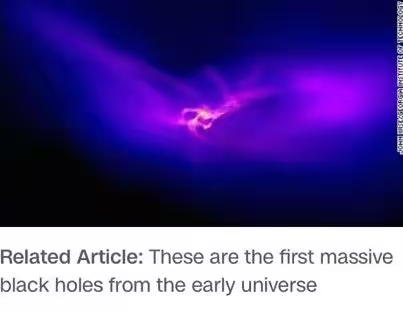“黑洞、黑洞”——
发布时间:2020-11-18 阅读次数:36029
CNN:
In April 2017, scientists used a global network of telescopes to see and capture the first-ever picture of a black hole, according to an announcement by researchers at the National Science Foundation Wednesday morning. They captured an image of the supermassive black hole and its shadow at the center of a galaxy known as M87.
This is the first direct visual evidence that black holes exist, the researchers said. In the image, a central dark region is encapsulated by a ring of light that looks brighter on one side.
The massive galaxy, called Messier 87 or M87, is near the Virgo galaxy cluster 55 million light-years from Earth. The supermassive black hole has a mass that is 6.5 billion times that of our sun. For reference, that's larger than the orbit of Neptune, which takes 200 years to make one orbit around the sun.
"We have seen what we thought was unseeable," said Sheperd Doeleman, director of the Event Horizon Telescope Collaboration. "We have seen and taken a picture of a black hole.”
The Event Horizon Telescope Collaboration, called EHT, is a global network of telescopes that captured the first-ever photograph of a black hole. More than 200 researchers were involved in the project. They have worked for more than a decade to capture this. The project is named for the event horizon, the proposed boundary around a black hole that represents the point of no return where no light or radiation can escape.
In their attempt to capture an image of a black hole, scientists combined the power of eight radio telescopes around the world using Very-Long-Baseline-Interferometry, according to the European Southern Observatory, which is part of the EHT. This effectively creates a virtual telescope around the same size as the Earth itself.
The telescopes involved in creating the global array included ALMA, APEX, the IRAM 30-meter telescope, the James Clerk Maxwell Telescope, the Large Millimeter Telescope Alfonso Serrano, the Submillimeter Array, the Submillimeter Telescope and the South Pole Telescope.
The observations were a coordinated dance in which we simultaneously pointed our telescopes in a carefully planned sequence," said Daniel Marrone, associate professor of astronomy at the University of Arizona. "To make sure these observations were truly simultaneous, so that we could see the same wavefront of light as it landed on each telescope, we used extremely precise atomic clocks at each of the telescopes.”
The telescope array collected 5,000 trillion bytes of data over two weeks, which was processed through supercomputers so that the scientists could retrieve the images.Details of the observation were published in a series of six research papers published in The Astrophysical Journal Letters.
What are black holes?
Black holes are made up of huge amounts of matter squeezed into a small area, according to NASA, creating a massive gravitational field which draws in everything around it, including light. They also have a way of super-heating the material around them and warping spacetime. Material accumulates around black holes, is heated to billions of degrees and reaches nearly the speed of light. Light bends around the gravity of the black hole, which creates the photon ring seen in the image.
The imaging methods used to capture the photo reveal that the supermassive black hole has a ring-like structure and a shadow, which is represented by a dark central region.
"If immersed in a bright region, like a disc of glowing gas, we expect a black hole to create a dark region similar to a shadow -- something predicted by Einstein's general relativity that we've never seen before," said Heino Falcke, chair of the EHT Science Council. "This shadow, caused by the gravitational bending and capture of light by the event horizon, reveals a lot about the nature of these fascinating objects and allowed us to measure the enormous mass of M87's black hole.”
The visual confirmation of black holes acts as confirmation of Albert Einstein's theory of general relativity. In the theory, Einstein predicted that dense, compact regions of space would have such intense gravity that nothing could escape them. But if heated materials in the form of plasma surround the black hole and emit light, the event horizon could be visible.
"Once we were sure we had imaged the shadow, we could compare our observations to extensive computer models that include the physics of warped space, superheated matter and strong magnetic fields. Many of the features of the observed image match our theoretical understanding surprisingly well," said Paul T.P. Ho, EHT Board member and director of the East Asian Observatory. "This makes us confident about the interpretation of our observations, including our estimation of the black hole's mass.”
M87's black hole has an enormous mass, which gave researchers reason to believe it may be the largest viewable black hole from Earth. Relative to other objects, supermassive black holes are actually small. This is why they couldn't be observed before. Black hole size is directly related to mass. The larger the black hole, the larger the shadow. And black holes may seem invisible, but the way they interact with the material around them is the giveaway, the researchers said.
"Black holes have sparked imaginations for decades," said National Science Foundation director France Córdova. "They have exotic properties and are mysterious to us. Yet with more observations like this one they are yielding their secrets. This is why NSF exists. We enable scientists and engineers to illuminate the unknown, to reveal the subtle and complex majesty of our universe."

